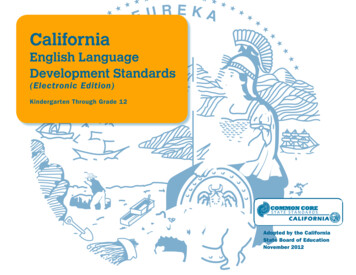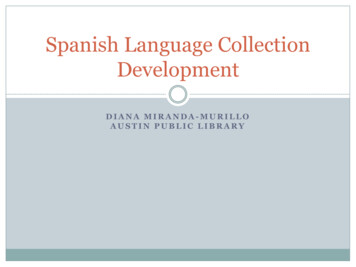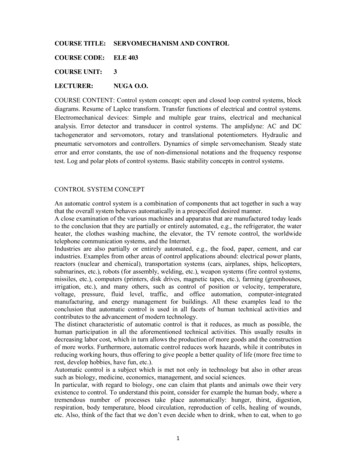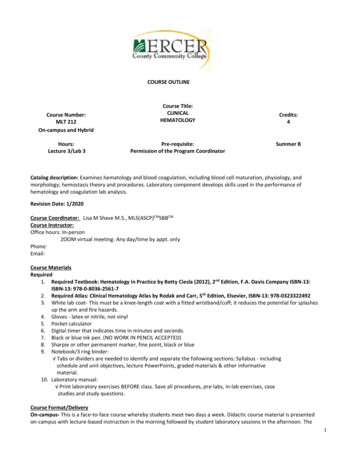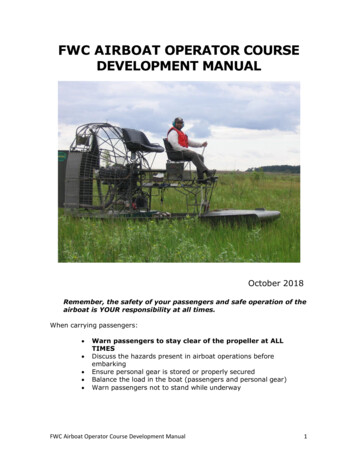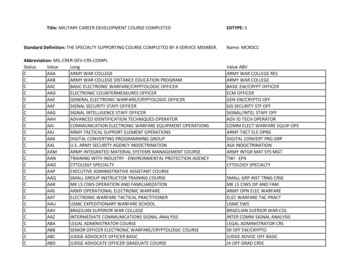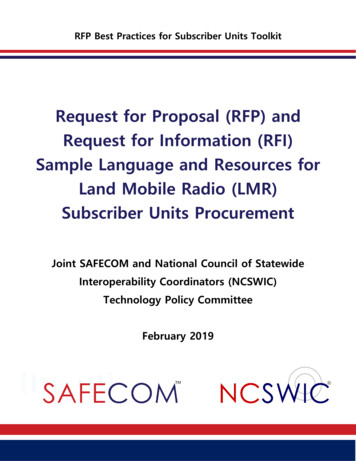
Transcription
in-courselanguagedevelopmentand support« a discussion paper »For a National Symposium: EnglishLanguage Competence ofInternational Students August2007
About This PaperThis paper was commissioned by Australian Education International (AEI) in the Department ofEducation, Science and Training (DEST) as background for and to aid discussion at a NationalSymposium: English Language Competence of International Students, held on 14 August 2007 inSydney. The preparation of this report was managed by the International Education Associationof Australia (IEAA).About AEI and DESTDEST is a department within the Australian Government, tasked with providing national educationand training leadership. DEST works with states and territory government agencies, industry andthe community in support of the Australian Government’s objectives.AEI is the international division of DEST. AEI works to integrate the development of internationalgovernment relations with support for the international activities of Australia’s education andtraining community.For further information go to: http://aei.dest.gov.au/Aei/Default.aspxAbout IEAAThe International Education Association of Australia (IEAA) is a lead professional organizationrepresenting members from the higher education, vocational education and training, Englishlanguage and schools sectors working in international education. Membership is drawn fromwithin Australia and internationally.For further information go to: www.ieaa.org.au.About the AuthorsDr Sophie Arkoudis is Senior Lecturer at the Centre for the Study in Higher Education, Universityof Melbourne.Dr Sue Starfield is Director of the Learning Centre and a Visiting Fellow in the Department ofLinguistics, University of New South Wales.AcknowledgementsAEI and IEAA would like to thank the members of the Project Steering Group for their time andcommitment in guiding this project.DisclaimerThe Commonwealth of Australia, its officers, employees or agents disclaim any responsibility forany loss howsoever caused whether due to negligence or otherwise from the use of informationin this publication. No representation expressed or implied is made by the Commonwealth ofAustralia or any of its officers, employees or agents as to the currency, accuracy or completenessof the information contained in this paper. The reader should rely on their own inquiries toindependently confirm the information and comment on which they intend to act. Commonwealth of Australia 2007This work is copyright. You may download, display, print and reproduce this material in unalteredform only (retaining this notice) for your personal, non-commercial use, or use within yourorganisation. All other rights are reserved. Requests and inquiries concerning reproduction andrights should be addressed to Attorney-General's Department, Robert Garran Offices, NationalCircuit, Barton, ACT 2600, or posted at http://www.ag.gov.au/cca .2
FOREWORDThis Discussion Paper is one of three commissioned by Commissioned by Australian EducationInternational in the Australian Department of Education, Science and Training for a one-dayNational Symposium, English Language Competence of International Students, held on Tuesday14 August 2007 at the Sheraton on the Park Hotel, Sydney.The Symposium will address the issues shaping the English language competence of internationalstudents and graduates in light of emerging research and in response to recent media coveragein Australia and overseas about the matter. The Symposium will address perceptions about thequality and effectiveness of the Australian international student program in relation to Englishlanguage competence of international students. Outcomes form the Symposium will informfuture policy and practice.The Discussion papers prepared for the Symposium are:Discussion Paper 1: Pathways – Preparation and SelectionDiscussion Paper 2: In-Course Language Development and SupportDiscussion Paper 3: Outcomes – Language, Employment and Further StudyThe aim of the Discussion Papers is to:Examine current knowledge and gaps in knowledge on the topic, drawing on Australian andwhere possible international research.Discuss implications for Australian policy and practice in this area.Identify critical issues for consideration by the Symposium.The broad aim of the Symposium is to consider what we know about the efficacy of Australianpolicy and practice in this area and to consider directions for enhancement of our knowledge andpractice.Outcomes of the Symposium will be presented in a final Symposium Report for widedissemination, including at the Australian International Education Conference to be held inMelbourne from 9-12 October 2007.IEAA is delighted to be working with AEI to foster discussion and debate and to further industryand community understanding within Australia about the issue of English language competenceof international students and thereby contributing to enhancing Australia’s reputation as a highquality international education provider.Dennis MurrayExecutive DirectorInternational Education Association of Australia3
CONTENTSExecutive Summary.51. Introduction .62. Models of Language Development and Support .72.1 Introduction . 72.2 Models of Practice . 72.2.1 Centralised and Decentralised Services . 72.2.2 One-on-one Consultations . 82.2.3 Workshops . 82.2.4 ESL for Credit Subjects . 92.2.5 Working Collaboratively with Disciplinary Staff . 92.3 International Models of English Language Support. 112.4 Critical Issues Concerning Models of Support . 113. Means of Accessing/Being Referred to Support Services.133.2 Self Selection . 133.3. Post-entry Diagnostic Assessment . 144. Evidence-based Good Practice Case Studies.174.14.24.34.44.5Introduction . 17Large Cohort Studies . 17Generic Workshops and Individual Consultations . 18English for Academic Purposes Courses . 19Case Studies of Content-based Interventions . 194.5.1 Beasley and Pearson Study . 194.5.2 Bretag Study . 204.5.3 Lubbers and Dale Study. 204.5.4 University of Wollongong Studies . 214.5.5 Larcombe & Malkin Study . 224.5.6 UNSW Enabling Skills . 224.5.7 University of Melbourne Medical Faculty . 234.5.8 Integration in a First-year Accounting Course . 235. Content of Support.245.1 Language Development and Academic Skills . 245.2 Critical Issues Concerning Content of Support . 266. Conclusion .284
EXECUTIVE SUMMARYThis paper explores critical issues surrounding English language support programs withinAustralian education. It should be noted from the outset that most of the research cited in thispaper is from higher education teaching contexts. This is due to the fact that there has been verylittle research within VET and schools concerning English language learning and teaching forinternational students. Moreover, the small amount of research that is available seems to reflectthe issues that arise in the literature on higher education. For these reasons, higher education isfore grounded in this paper and where, applicable, references are made to other sectors.Language and academic support programs (LAS) have evolved in response to the growingeducational needs of international students and the concerns of their teachers. These programshave undergone a shift in emphasis from generic to discipline-specific skills teaching. The focusis on teaching language and academic skills rather than study skills. The emphasis is moredevelopmental than remedial. While Australian English language support programs are furtheradvanced in these aspects when compared to UK and USA higher education, the discussion inthis paper emphasises that at this time of increased competition in the international educationmarket we need to be exploring ways of developing best practice in English support programs.This paper highlights issues for both policy and practice, which can lead to developing highquality English language support programs that enable international students to achieve withintheir academic communities and further increase the reputation of Australian education withinthe international student market. In order to achieve this, the following critical issues need to beaddressed: Implementing post-entry testing programs such as The Diagnostic English LanguageAssessment (DELA) and the Diagnostic English Language Needs Assessment (DELNA) toidentify ‘at risk’ students and offer targeted support for international students upon entryto courses.Supporting qualitative and quantitative evaluative research on the different models oflanguage support and student outcomes across the sectors should be encouraged andclear outcome indicators developed.Researching the processes and practices involved in developing and maintaining effectivecollaboration between language support staff and disciplinary staff should be encouragedby educational institutions.Articulating clear career pathways and qualification levels for staff involved in academicEnglish language teaching.Incorporating key stakeholders such as students, academic staff, language support staff,directors of teaching and learning and staff involved in recruitment and marketing inresearch, in order to inform policy and practice at an institutional, departmental andindividual level.Extending quality assurance indicators to include academic English language learning andteaching for both onshore and offshore teaching programs across the different sectors.Developing best practice requires increased research and funding for English languageprograms to support English language development. Simply raising the minimum Englishlanguage entry pathways will not address the issue of international students acquiring theEnglish language knowledge and skills necessary for study at the appropriate level.Without addressing some of these issues, it is very difficult to state whether the currentAustralian system is adequate, because we have very little evaluative evidence to justify anyclaims we may make.5
1. INTRODUCTIONWe are writing this paper in a climate in which there is great public concern about the languageproficiency of international students. The Birrell (2006) study, extensive media coverage and theconcerns of many academics and students echo this.There appears on the face of it to be a mismatch between the popular view that language is aproblem for overseas students and the large scale reviews we discuss in Section 3 which indicateno significant differences in overall pass rates of overseas and local students both in Australiaand in the UK. The evidence from the UTS study also discussed in Section 3 and other casestudies we examine suggests however that language is a barrier to student success.How do we understand this disjuncture? Obviously, international students already receive largeamounts of support which may be assisting their completion rates. Media coverage andanecdotal reports by academics suggest concern over assessment standards. As we propose,greater research is needed into this complex area and clear quality indicators of outcomes needto be developed by key stakeholders for onshore as well as offshore students.Academic language learning is linked to a set of purposes that place high cognitive and linguisticdemands on the learner.Students are learning the particular ways of thinking andcommunicating in their language of their disciplines – some call this academic discourse – and itcan be challenging for nati
14 August 2007 at the Sheraton on the Park Hotel, Sydney. The Symposium will address the issues shaping the English language competence of international students and graduates in light of emerging research and in response to recent media coverage




